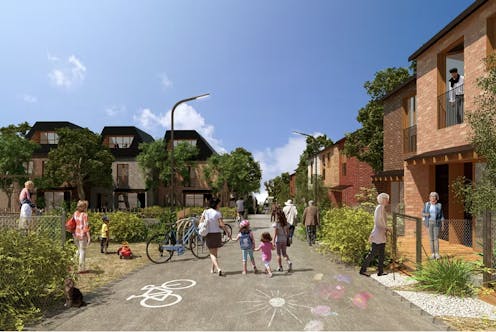how to renew our suburbs for more liveable, net-zero cities
- Written by Peter Newman, Professor of Sustainability, Curtin University

Our ageing cities are badly in need of regeneration. Many established residential areas, the “greyfields”, are becoming physically, technologically and environmentally obsolete. They are typically located in low-density, car-dependent middle suburbs developed in the mid to late 20th century.
Compared to the outer suburbs, these middle suburbs are rich in services, amenities and jobs. But the greyfields also represent economically outdated, failing or undercapitalised real-estate assets. Their location has made them the focus of suburban backyard infill development.
Unfortunately, the current approach typically cuts down all the trees and creates more car traffic as resident numbers grow. A new kind of urban regeneration is needed at the scale of precincts, rather than lot by lot, to transform the greyfields into more liveable and sustainable suburbs. It calls for a collaborative approach by federal, state and local governments.
How do we do this?
Our free new e-book, Greening the Greyfields[1], sets out how to do this. It draws on ten years of research that led to a new model of urban development.
This approach integrates two goals of urban research:
ending the dependence on cars caused by a disconnect between land use and transport[2]
accelerating the supply of more sustainable, medium-density, infill housing to replace the current dysfunctional model[3] of urban regeneration.
Greening greyfields will help our cities make the transition[4] to net zero[5] emissions.
Read more: Australia's cities policies are seriously inadequate for tackling the climate crisis[6]
Why do we need to regenerate these areas?
We need to shrink the unsustainable urban and ecological footprints of “suburban” cities. Neighbourhoods need to become more resilient, sustainable, liveable and equitable for their residents.
Urban regeneration must also allow for the COVID-driven restructuring of the work–residence relationship for city residents. This involves relocalising urban places so they become more self-sufficient as “20-minute neighbourhoods[7]”. Their residents will have access to most of the services they need via low-emission cycling and walking, as well as public transport.
Read more: People love the idea of 20-minute neighbourhoods. So why isn't it top of the agenda?[8]
Current attempts to increase residential density and limit sprawl in most Australian cities tend to focus on blanket upzoning in selected growth zones. The resulting backyard infill involves a few small homes, which is all that is allowed on each block. Density increases only marginally, so there are still too few housing options for residents who want to be close to city services and opportunities.
Piecemeal infill redevelopment often degrades the quality of our suburbs. The loss of trees and increase in hard surfaces worsen urban heat island effects and flood risk. And a lack of convenient transport options for the extra residents reinforces car dependence.
We need more strategic models of suburban regeneration.














